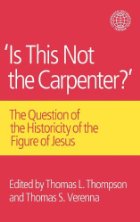I recently caught up with Michael Turton’s review of Bart Ehrman’s Did Jesus Exist? — all too belatedly. His remarks apply to probably most historicist scholars who have commented on the mythicist question. But this section struck me as worthy of catching a wider attention:
In reality, the mythicist-historicist debate is a clash of competing interpretive frameworks, a clash over the same body of data over which there are divergent interpretive views — one of which claims success because it has powerful social support. This is not an uncommon phenomenon in the social and historical sciences.
Readers who are familiar with the history of science can probably name many examples of how social approval in a historical or human field for a given interpretation of the data hindering consideration and acceptance of new ideas. The struggle to overcome the Clovis First interpretive framework that came to dominate North American archaeology until about three decades ago is a good example (the battle is still ongoing, and will likely end when the last of the Clovis Firsters dies off). Another good example is the way paleoanthropology was changed by the influx of females in the 1960s; the interpretive frameworks had been dominated by males and their points of view. Every August in the US we see another example of the clash of competing interpretive frameworks over how the atomic bombings of Japan should be understood.
Thus, the reader should be aware that the clash between mythicists and historicists is not a clash between loons similar to those who think the moon landings were faked and NASA, or between Creationists and real scientists, as Ehrman would have it. That is mere rhetoric, lazy, cheap shots.* In evolutionary biology or climate science the methodologies are robust and testable and the evidence overwhelming and the Denialists on either part are essentially anti-science. Historical explanation is not like scientific explanation (though it may draw on it), and scholars who bluster that mythicists are like Creationists are (probably deliberately) making a serious category error.
In historical Jesus studies both mythicists and historicists learn the same ancient languages and study the same texts, using the same methodologies. Both sides keenly appreciate and esteem good scholarship and hold basically the same set of New Testament scholars in high regard, including Ehrman himself. I suspect that if you compared the bookshelves of most people writing on mythicism with Ehrman’s own, they would look very much alike. None of the major mythicist writers can remotely be described as anti-science or anti-scholarship. Again, the problem is not denial of reality, but a clash of competing interpretive frameworks. . . . . Continue reading “Michael Turton on the Mythicist-Historicist Debate”

